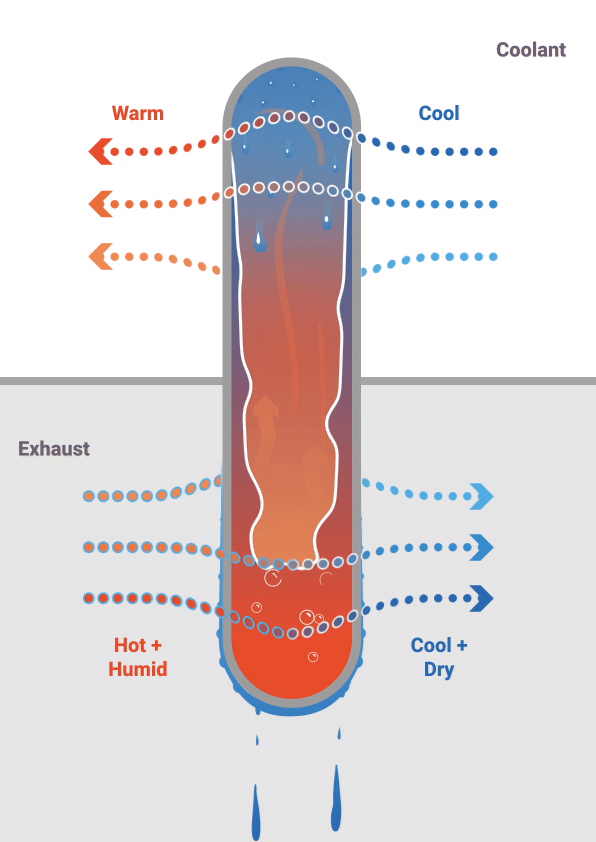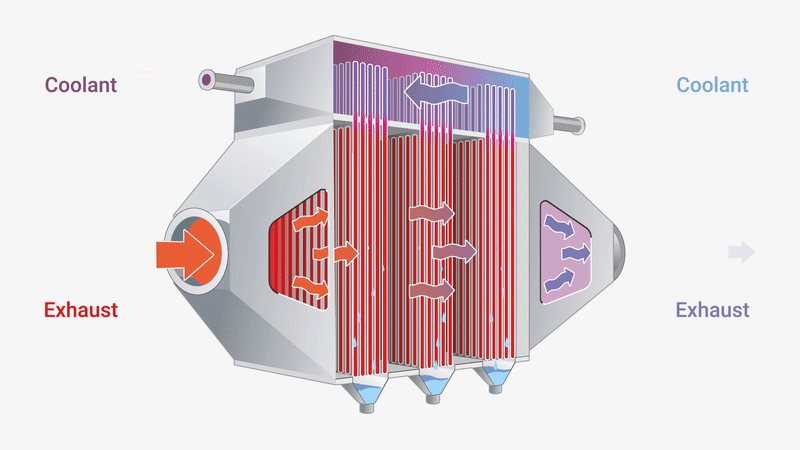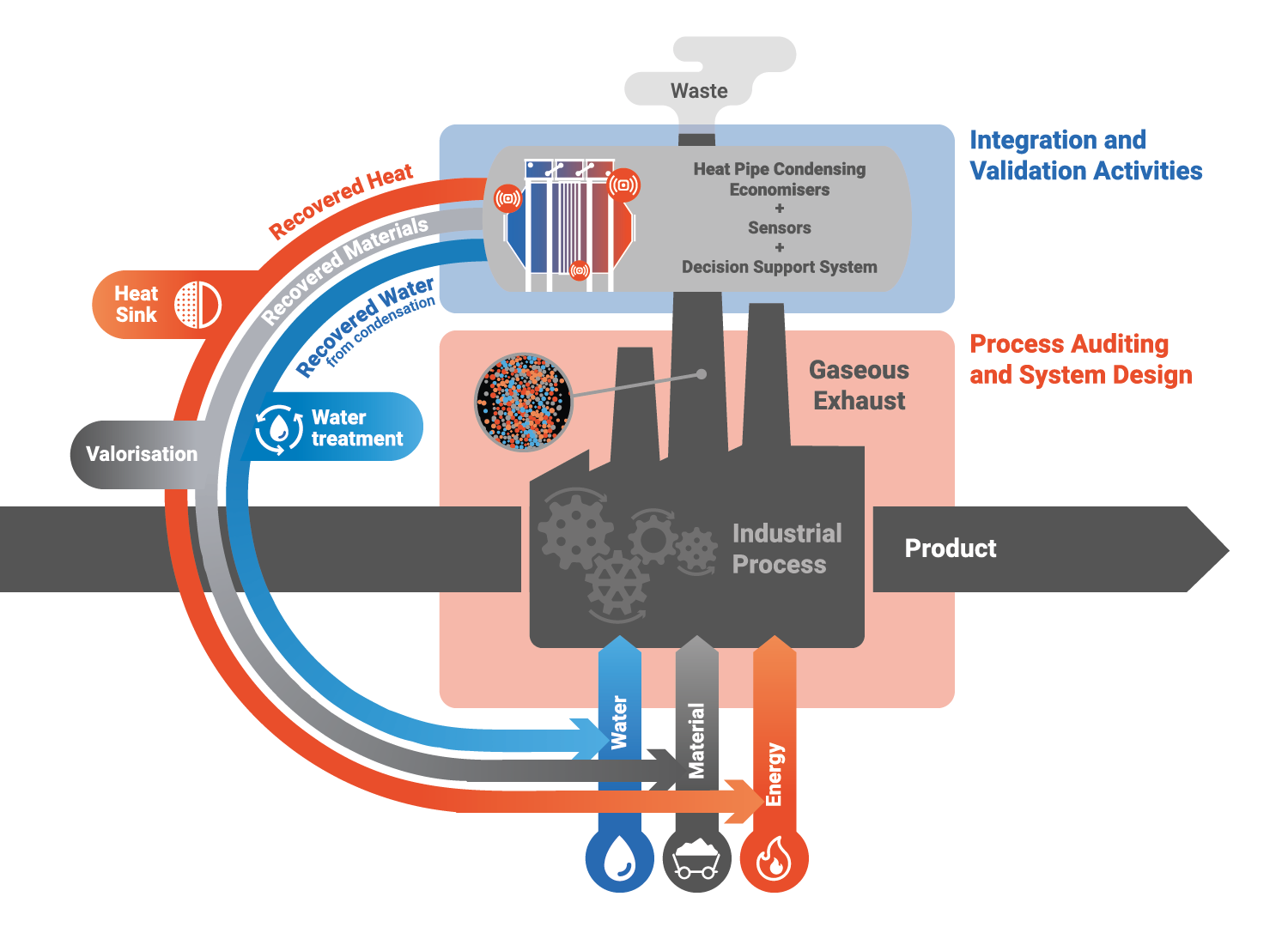Heat Pipe Technology
Heat pipes are one of the core technologies employed by the iWAYS project. They are an incredibly efficient tool to recover heat from one industrial process and apply it in another.
A heat pipe transfers thermal energy passively from a hot to a cold stream by a boiling condensation cycle inside a hermetically sealed metal tube. In this way, heat from the hot area can be transferred very efficiently to a cold part of the pipe.
In the iWAYS project, the engineers will combine many heat pipes to create a heat exchanger design, also known as a Heat Pipe Condensing Economiser (HPCE), according to the specific needs of each production plant.
The diagram shows the heat pipe principle operating within the context of a HPCE. The sealed pipe contains a working fluid. Absorbing heat at the lower end, the liquid vaporises and carries the thermal energy upwards to the condenser section, where it encounters a lower temperature. Consequently, the vapour condensates (back to a liquid) and thereby releases heat. The liquid runs down the inner walls back to the evaporator section where the process starts over again.

Heat Pipe Condensing Economisers (HPCE)
Within a Heat Pipe Condensing Economiser many heat pipes work together in parallel in a container where hot exhaust air passes by at the bottom to heat the liquid inside the tubes. At the other end of the HPCE, fresh air or water flows along, absorbing the heat of the condenser sections. This heated air or water can now be transported to parts of the production line where it can be re-used.At the same time water of the humid and hot exhaust air condensates along the exterior of the pipes, drips to the bottom where it is being collected. This way both heat and water is recovered by the HPCE.

Common Heat Exchangers faces several challenges in industrial applications, because of the corrosive and fouling exhaust (containing particulates or suspensions that could settle onto the surface). The fouling, caused by solid particles and other contaminants in exhaust gases, can be mitigated by HPCE with the appropriated design and also tuning by coatings and/or surface post treatment.
iWAYS will investigate and develop both numerical models of fluid dynamics and coating or surface treatments to optimise HPCE functioning. The project will exploit two main HPCE applications: a) recovery of water vapor generated during moisture removal processes and b) water recovery from combustion.
Sensors
Sensors will be deployed to accurately report on the qualitative and quantitative attributes of sustainable water sources. The type and quality of the sensors will be determined according to the demand and nature of the demo cases and its water loops, as well as the cost, effectiveness and the reliability of the solutions. State of the art sensors and actuators will be deployed in industrial processes that currently are not monitored. The physical systems will be equipped with the hardware and software capabilities
Decision-Support Systems
Real-time Decision-Support Systems (DSS) enable operators to evaluate the future management of hydraulic structures. The iWAYS project will develop a flexible process monitoring, control and optimisation dashboard for evidence-based decision making. A software platform with improved 3D visualisation and data analytics will be developed. The DSS will serve as a basis for full-scale implementation of the selected measures in real conditions.
Heat, Water and Materials recovery
Optimizing energy efficiency in production plants has its limits. Waste heat is unavoidable when products or hot air needs to cool down – especially in industries requiring high temperatures. The good news: the high amount of excessive heat offers industries great potential for increasing efficiency, reducing their energy input and saving costs.

When it comes to water and thermal energy recovery, Heat Pipes Condensing Economisers are envisioned to play a critical role in the future. With their help, waste heat and water can be channelled to other processes within the same facility. Waste air flow can be recovered to preheat combustion air, for example, and wastewater from the exhaust steam can be collected, treated and applied to other areas of the industrial process forming a closed loop. The water treatment could additionally help to filter out valuable materials, such as hydrogen fluoride for example, making the Heat Pipe Condensing Economiser an invention that recovers both heat, water and materials from an exhaust stream.
To address the specific challenges of different industries, iWAYS is developing several HPCE units to be installed in different use cases: in a ceramic tile factory in Italy, an aluminium fluoride production plant in Sweden and a steel tubes manufacturer in Spain.